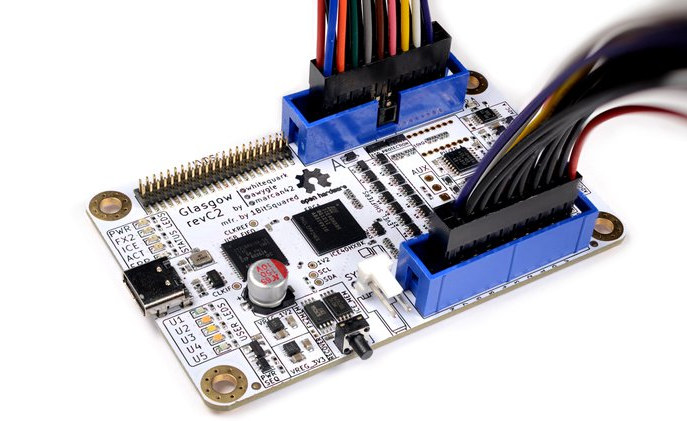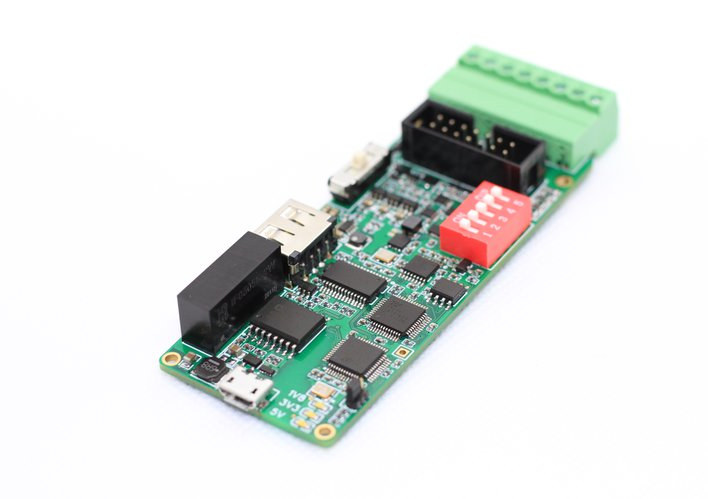We’ve seen some interesting USB hardware hacking/debugging boards in the last two months with Tigard, Ollie, and Glasgow Interface Explorer each with their own price point and features, but with the goal of replacing multiple other programming or debug boards you may need for your projects. Protocol Droid is another one of such USB boards for electronics designers and hardware hackers. It offers I/O connectivity via terminal blocks for I2C, CAN Bus, RS485, UART, SPI, and other interfaces. Protocol Droid key features and specifications: MCU – Unnamed STMicro microcontroller Host interface – Micro USB port Core Interfaces: I²C controller & peripheral modes SPI controller & peripheral modes RS485 controller & peripheral modes CAN Bus UART 2x PWM 2x ADC 2x DAC Debugging / programming interfaces – 7-pin JTAG/SWD unpopulated header Power Sources – 3V & 5V DC with limited current via 2-pin terminal blocks All interfaces are available simultaneously through […]
Glasgow Interface Explorer is an iCE40 FPGA based hardware debugging tool (crowdfunding)
We’ve seen some pretty interesting boards for hardware hackers and reverse engineers in recent months with the likes of Ollie and Tigard USB debug boards that allow interfacing various hardware interfaces and/or flashing firmware to different types of target boards. Here’s another one: Glasgow Interface Explorer. Based on Lattice Semi iCE40 FPGA, the board is described as being “designed for hardware designers, reverse engineers, digital archivists, electronics hobbyists, and anyone else who wants to communicate with a wide selection of digital devices with minimum hassle”. Glasgow Interface Explorer specifications: FPGA – Lattice Semiconductor iCE40HX8K FPGA USB – 1x USB-C port connected to FX2 high-speed USB interface capable of 480 Mbps throughput I/O headers 2x 8-channel I/O banks with 16 highly flexible I/O Each I/O bank comes with A dedicated programmable linear voltage regulator, configurable from 1.8 V to 5 V and providing up to 150 mA of power A dedicated […]
Onion Tau is an affordable 3D depth LiDAR camera (Crowdfunding)
Onion is better known for its Omega IoT boards running OpenWrt, but the company has now come up with a completely different product: Onion Tau 3D depth camera equipped with a 160×60 LiDAR sensor. The device plugs like a USB webcam to a host computer or board, but instead of transferring standard images, the camera produces 3D depth data that can be used to detect thin objects, track moving objects, and be integrated into other applications leveraging environment mapping such as SLAM (Simultaneous localization and mapping). Onion Tau LiDAR camera (TA-L10) specifications: Depth technology – LiDAR Time of Flight Depth stream output – 160 x 60 @ 30 fps Depth range – 0.1 to 4.5 meters Depth field of view (FOV) – 81˚ x 30° Grayscale 2D camera image sent with 3D depth map data Host interface – USB Type-C port Dimensions – 90 x 41 x 20 mm; 4x […]
Hackboard 2 Intel Celeron N4020 SBC comes with optional 4G/5G cellular modem (crowdfunding)
We’ve seen several x86 SBCs made for the makers’ community including AAEON Up Board family, AMD powered UDOO BOLT boards, and Seeed Studio Odyssey-X864105 SBC and mini PC. Hackboard 2 is another one of those single board computers. Powered by a dual-core Intel Celeron N4020 Gemini Lake Refresh processor coupled with 4GB DDR4 RAM and 64GB eMMC flash, the board offers the usual HDMI, Ethernet, USB ports, plus a 40-pin Raspberry Pi header, and an optional 4G or 5G modem. Hackboard 2 specifications: SoC – Intel Celeron N4020 dual-core Gemini Lake Refresh processor @ 1.1 GHz / 2.8 GHz (Turbo) with 4MB cache, Intel UHD graphics 600; 6W TDP System Memory – 4GB DDR4 RAM Storage – 64 GB onboard eMMC flash, 2x NVMe M.2 slots for up to 4 TB additional storage Video output HDMI 2.0a output up to 4K 30-pin eDP connector for 11.6″ to 15.6″ displays 6-pin […]
Ollie USB board exposes isolated UART, CAN, USB, RS485 & RS232 interfaces (crowdfunding)
Just like months, we wrote about Tigard open-source USB FT2232H board for hardware hacking with easy access to OpenOCD, JTAG, Cortex, flashrom interfaces used to debug/flash boards, extra I/Os with UART, SPI, and I2C, as well as a header to connect a logic analyzer and observe signals. If the board does not exactly match your requirements, Ollie USB board might, also it may not serve exactly the same purpose(s). The board acts as a USB bridge to isolated UART (x2), CAN, USB, RS485, and RS232 interfaces. Ollie specifications: MCU – STMicro STM32F042 Arm Cortex-M0 microcontroller with CAN interface Host interface – Micro USB port Isolated interfaces (all with ESD protection) 2x UART ports up to 12 Mbps with 1.8/3.3/5 V voltage levels (set by slide switch) CAN bus based on CANable/CANtact open hardware, flashed with dual firmware CANtact and Candlelight (switch selectable) and equipped with termination resistor switch Downstream USB […]
MorphESP 240 ESP32-S2 board integrates a 1.3-inch color display (Crowdfunding)
We’ve already seen ESP32 platforms with a color display such as M5Stack, but MorphESP 240 is kind of cute with a 1.3-inch color display, features the more recent ESP32-S2 WiFi processor, and supports battery power & charging. MorphESP 240 specifications: Wireless Module – ESP32-S2-WROOM with Espressif Systems ESP32-S2 single-core 32-bit Xtensa LX7 microprocessor up to 240 MHz with 128 KB ROM, 320 KB SRAM, 16 KB SRAM in RTC, 4MB SPI flash, 802.11 b/g/n 2.4 GHz Wi-Fi connectivity Display – Onboard 1.3-inch ST7789 display with 240 x 240 resolution, connected over SPI USB – 1x Micro USB port for power/charging and programming Expansion – 16-pin and 24-pin headers with GPIO, I2C, UART, SPI, USB, and power signals Misc – WS2812B RGB LED connected to IO16, Reset button, boot mode switch, battery on/off switch Power Supply 5 V to 3.3 V regulator to feed additional modules JST connector for a battery […]
8-MOSFET solid-state power driver works with Raspberry Pi, Arduino, ESP32 and other maker boards (Crowdfunding)
Using inexpensive relays to switch AC or DC loads work well in most cases, but those relays will be quickly damaged when faced with high DC voltages, fast switching times, or other endurance requirements for which MOSFET’s are better suited, and that’s why MOSFET power supplies are found in 3D printers. Sequent Microsystems has made a habit to provide specialized Raspberry Pi HAT with relays or terminals for resistance temperature detectors that are stackable to supports a larger number for I/O or sensors. The company is now back at it with the 8-MOSFET stackable, DIN-rail mountable board that works not only with Raspberry Pi SBC, but also popular Arduino, ESP32, and other maker boards. 8-MOSFET key features and specifications: Eight MOSFETs with status LEDs 4 optimized for high-current (HC) loads up to 10 A / 24 VDC 4 optimized for high-voltage (HV) loads up to 2 A / 240 VDC […]
Tigard is an open-source FT2232H board for hardware hacking (Crowdfunding)
There is plenty of cheap 5V or 3.3V USB to TTL debug boards used to access the serial console and/or program boards, but FTDI FT2232H based Tigard open-source hardware board does much more than that as it supports multiple protocols, multiple voltages for hardware hacking & debugging. The developer explains Tigard can be used as a drop-in replacement for dozens of other hardware tools based on FTDI chips and includes native support OpenOCD, FlashROM, and more. Tigard board specifications: Main chip – FTDI FT2232HQ dual high-speed USB to multi-purpose UART/FIFO IC Primary port dedicated to UART including access to all flow control signals Secondary port shared among dedicated headers for SWD, JTAG, SPI, and I²C USB – USB 2.0 Type-C (480 Mbps) port I/Os 9-pin UART header Qwiic I2C connector 8-pin SPI & I2C header 8-pin JTAG header 10-pin Cortex debug header 14-pin logic analyzer (LA) header to observe device-level […]










